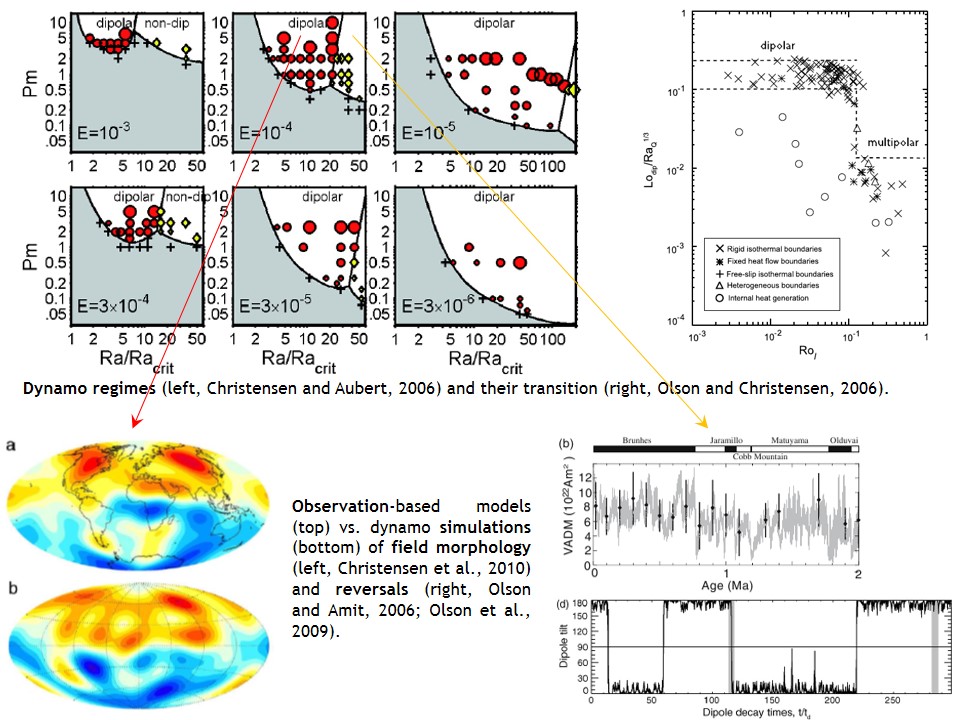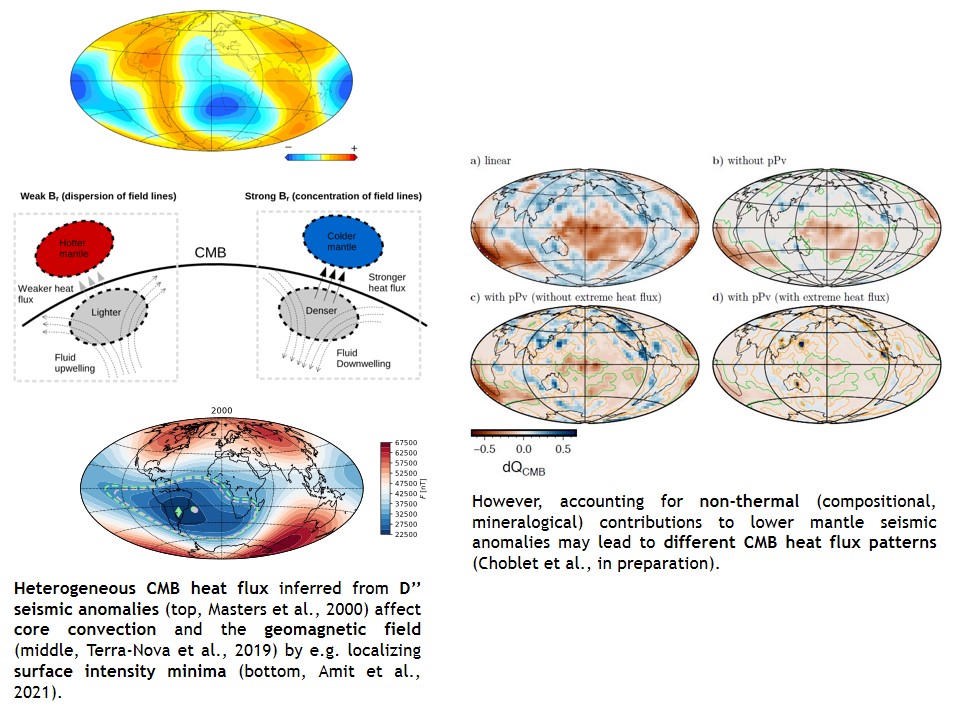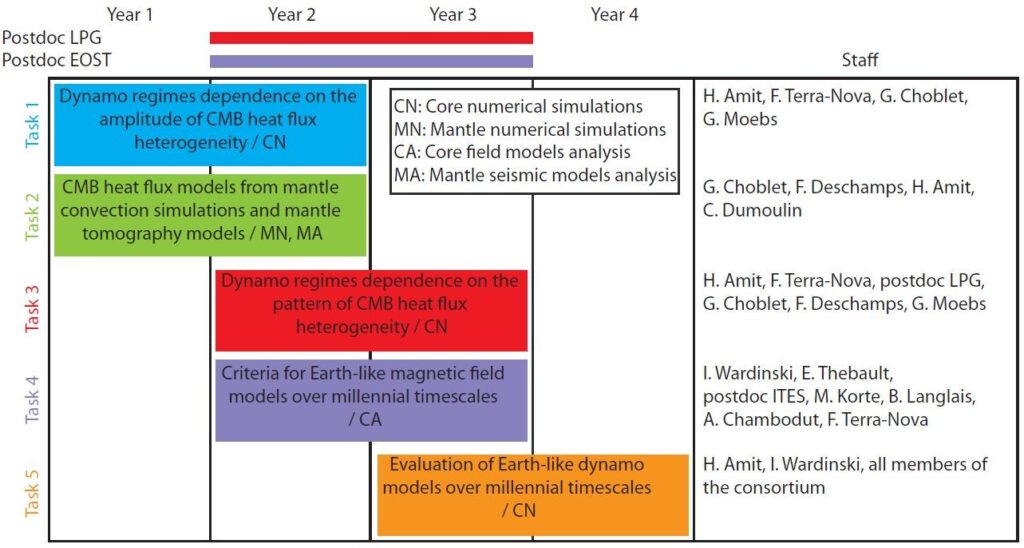DYRE-COMB project
a. Objectives and research hypothesis
The structure and dynamics of Earth’s mantle and core are determined by the heat flux across the core-mantle boundary (CMB) (Lay et al., 2008). As stated in a recent review on geodynamo modelling (Wicht and Sanchez, 2019), significant progress was achieved by “incorporation of effects like the heat flux pattern imposed by Earth’s mantle”. The CMB heat flux pattern readily affects the morphologies of core convection and the generated geomagnetic field (see Amit et al., 2015a and references therein). Paleo- and archeomagnetic field models (Korte et al., 2009; Panovska et al., 2018) which span from several millennia up to the past 100 kyrs provide valuable insights into persistent features that may be controlled by the lower mantle thermal heterogeneity. This includes the South Atlantic Anomaly (SAA) – a region of particularly weak geomagnetic field intensity at Earth’s surface, where energetic particles penetrate the atmosphere thus posing severe problems to positioning systems and spacecraft electronics(Heirtzler, 2002). Our goal is to identify such persistent geomagnetic field features in paleomagnetic observations, which then will be used to evaluate how Earth-like are the fields produced by dynamo models with heterogeneous outer boundary heat flux.
To recover geodynamo features that are controlled by lower mantle thermal heterogeneity, a precise knowledge of the CMB heat flux pattern is needed. Compositional and mineralogical contributions to the lateral variability of the seismic velocity in the D’’ layer distort inferences of the CMB heat flux from seismic tomography. We will infer thermal-seismic relations from mantle convection simulations in order to isolate the thermal part of the seismic anomalies. Our objective is to apply this relation to mantle tomography models (e.g. Houser et al., 2008) in order to properly model the CMB heat flux.
Lower mantle thermal heterogeneity may strongly affect the properties of core dynamics and the geodynamo (Amit et al., 2015a). The most fundamental property of dynamo models is their regime, i.e. whether the generated magnetic field is dipole-dominated non-reversing or multipolar reversing (Christensen and Aubert, 2006). The geodynamo exhibits transitions between these two states. The present day geomagnetic field is dipole dominated (e.g. Jackson et al., 2000), while the paleomagnetic record is punctuated by numerous reversals and excursions during which the dipole was weak (e.g. Merrill et al., 1998). One interpretation of dynamo models places Earth’s core close to this transition (Olson and Christensen, 2006) so that small changes in the core convection vigor or rotation rate may result in regime change (Driscoll and Olson, 2009), thus reconciling the dipole-dominated present-day field and the occurrence of reversals in the paleomagnetic record. This project aims at establishing the necessary ingredients for each dynamo regime, taking into account the CMB heat flux pattern and amplitude of heterogeneity. Using adequate CMB heat flux models and testing the consistency of the dynamo models output with criteria derived from paleomagnetic field models, our goal is to evaluate the Earth-likeness of the fields resulting from a large set of geodynamo models with heterogeneous outer boundary heat flux.
This project aims at establishing the impact of the heterogeneous CMB heat flux on the dynamo regimes and the resulting geomagnetic field. Owing to its specific architecture based on independent tasks, the DYRE-COMB project will deliver a fundamental and improved understanding of deep Earth dynamics on both sides of the CMB. Our main objectives are presented via the following questions :
- What is the present pattern of CMB heat flux?
- What are the characteristic features of Earth’s magnetic field on millennial timescales? Is the SAA a persistent feature of the geomagnetic field?
- What are the necessary ingredients for Earth-like magnetic fields on millennial timescales in dynamo models?
- How do the dynamo regimes depend on the amplitude and pattern of CMB heat flux heterogeneity?
To overcome the scientific barriers associated with each of these objectives, we will combine seismic tomography models, mantle convection simulations, numerical dynamo simulations and geomagnetic field models over different periods. Objective 1 will be tackled by inferring the relation between seismic and thermal anomalies in mantle convection simulations and applying this relation to mantle tomography models (task 2). Objective 2 will be addressed by a thorough analysis of recurrent spatial features in a set of geomagnetic field models (task 4). The barrier of objectives 3 and 4 will be lifted by performing a systematic parametric study of numerical dynamos with heterogeneous outer boundary heat flux (tasks 1 and 3). Finally, task 5 will merge the results of the four first tasks to address the core objective of the project.
Expected results include an ensemble of realistic CMB heat flux models, criteria for Earth-like magnetic field models on millennial timescales and unravelling the dependence of dynamo regimes on the CMB heat flux heterogeneity, amplitude and pattern. The latter part of the project contains riskier investigations. If we find that the geodynamo is indeed close to the transition between dipole-dominated to reversing regimes then small changes in core convection vigor or rotation rate may result in regime change (Driscoll and Olson, 2009), thus reconciling the dipole-dominated present-day field and the occurrence of reversals in the paleomagnetic record. In contrast, a heterogeneous CMB heat flux may stabilize a corresponding reversing dynamo with homogeneous boundary conditions or destabilize an otherwise non-reversing dynamo (e.g. Glatzmaier et al., 1999; Olson et al., 2010). Therefore, our models which include the effects of CMB heat flux heterogeneity might disprove the scenario of the geodynamo being close to the non-reversing to reversing transition and localize the geodynamo far from this transition. Another risky investigation involves the persistence of the SAA. While episodes of weak surface field in the South Atlantic were identified in paleomagnetic field models (Brown et al., 2018), it is not clear if this region exhibits statistically significant recurrence of such anomalies.


b. Methodology and risk management
To achieve the objectives of this project, we designed a detailed work plan comprised of five tasks. The schedule and the staff involved in each task are displayed in Fig. 3. The tasks are described below.

Fig. 3: Tasks, work schedule, organization and staff
Coordinator and partners : the Project Coordinator is Hagay Amit, CNRS Research Fellow at LPG. The “Institut Terre et Environnement de Strasbourg” (ITES) and the “Laboratoire Magmas et Volcans” (LMV) contribute to the project.

